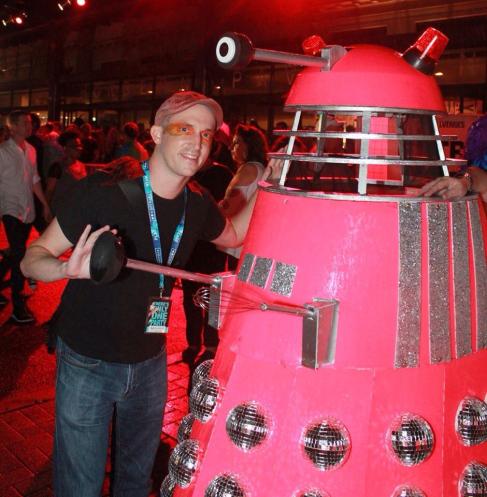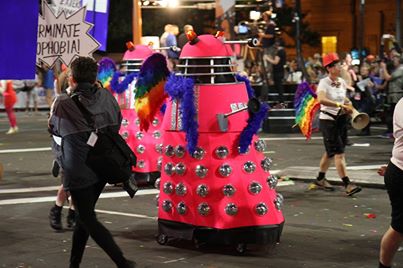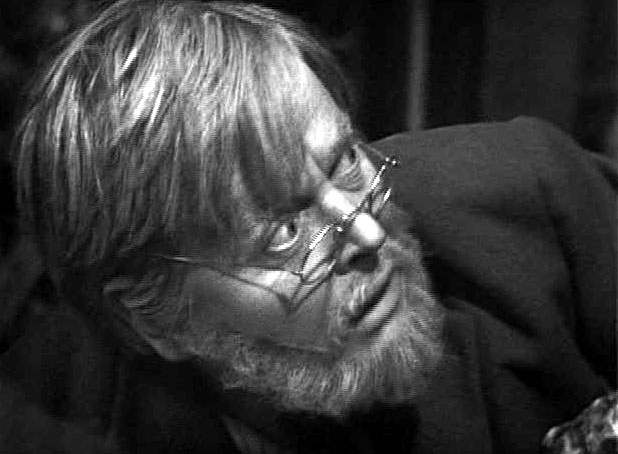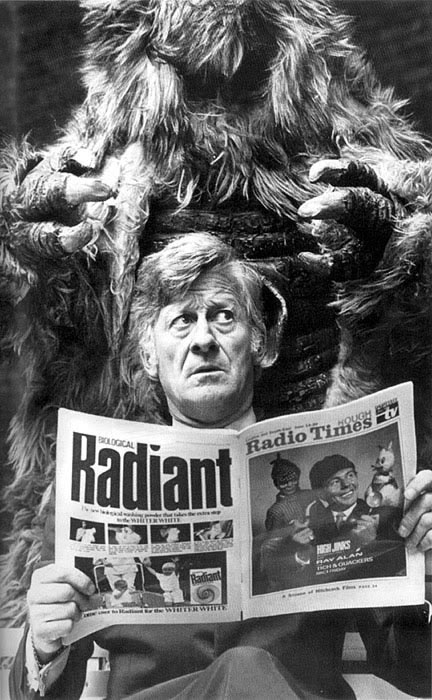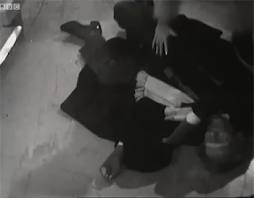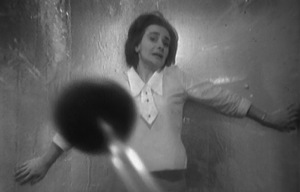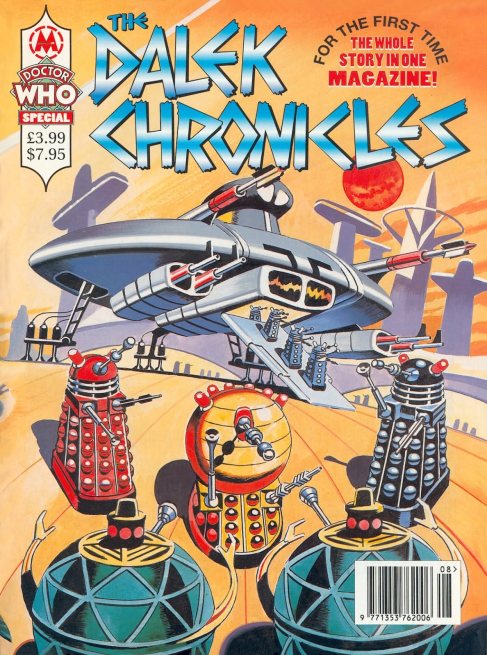
Doctor Who’s long history of non-human villains has its genesis in the show’s second ever serial, The Daleks. Choosing the Top 5 is relatively easy given the extraordinarily high attrition rate of monsters considered to be “the next big thing”. Starting with Terry Nation’s The Sensorites, and ending with Robert Homes’ The Krotons, the Sixties were littered with the carcases of monsters that never quite made the grade. The Dominator’s Quarks, The Underwater Menace’s benevolent Fish People, The Macra Terror’s Macra, The War Machines’ WOTAN and War Machines, Galaxy 4’s Rill, The Chase’s Mechonoids, and The Web Planet’s Zarbi and Menoptra are but a few examples.

One of the less successful monsters of the Sixties, the Fish People from The Underwater Menace
In essence, any 1960s monster that scored a repeat story in that decade has made The Doctor Who Mind Robber’s list of the Greatest Monsters of the Sixties. All have been revived in New Series Doctor Who, with the exception of the Yeti. Please see Day 49 of our countdown for the Ten Least Remembered Monsters of the Sixties.
5. The Great Intelligence – The Abominable Snowmen and The Web of Fear
When Colonel Lethbridge-Stewart asked the Doctor in The Web of Fear what the Great Intelligence was he responded by saying, “Well, I wish I could give you a precise answer. Perhaps the best way to describe it is a sort of formless, shapeless thing floating around in space like a cloud of mist, only with a mind and will”.
The Doctor, Jamie and Victoria first encountered the Great Intelligence at the Det-Sen monastery in 1935 Tibet (The Abominable Snowmen). Having possessed the body of the monastery’s Master, Padmasambhava, this otherwise disembodied sentient being permitted its host to live up to 300 years. The Intelligence forced Padmasambhava to build him an army of robot Yeti, the construction of which took over 200 years. The Yeti were controlled by small hand-made pyramids. The Intelligence’s plans to take over the mountain on which the monastery stood were thwarted when the Doctor, Edward Travers and the companions destroyed the pyramids. Padmasambhava finally found the peace he so desired when his body passed away and the Intelligence again became a sentient being without a parasitic body.

The Abominable Snowmen’s Padmasambhava was possessed by the Great Intelligence
The Doctor and his companions again met the Intelligence when they found themselves in the London Underground 40 years later. In The Web of Fear their old friend Professor Travis had inadvertently facilitated the reactivation of the Yeti. The Doctor, Jamie and Victoria teamed up with members of the British Army to thwart the Intelligence’s plans for domination. The Intelligence used the body of the deceased Staff Sergeant Arnold and even Professor Travers for a short time. The Intelligence sought to possess the Doctor’s body and to drain his mind with a conversion headset. Unbeknownst to his companions, the Doctor had already reversed the settings so that it was the Intelligence’s mind, rather than his own, that would be drained. Jamie, however, smashed the control spheres prior to the Doctor sapping the Intelligence’s mind. Although still alive, the Intelligence vanished and was never again seen by the Second Doctor.

Staff Sergeant Arnold was possessed by the Great Intelligence in The Web of Fear
4. The Yeti – The Abominable Snowmen and The Web of Fear
Although briefly seen in the 20th Anniversary Special, The Five Doctors, the Yeti have only been the central players of two serials, The Abominable Snowmen and The Web of Fear. Robotic servants of the Great Intelligence, the first Yeti were manufactured by Padmasambhava at the Intelligence’s command. Rather pear shaped and cuddly, the Mark 1 Yeti were not as threatening in appearance as their Mark 2 counterparts which had claws capable of holding web-guns and were more streamlined. Exactly who assisted the Intelligence in the production of the Mark 2 Yeti of The Web of Fear has never revealed.
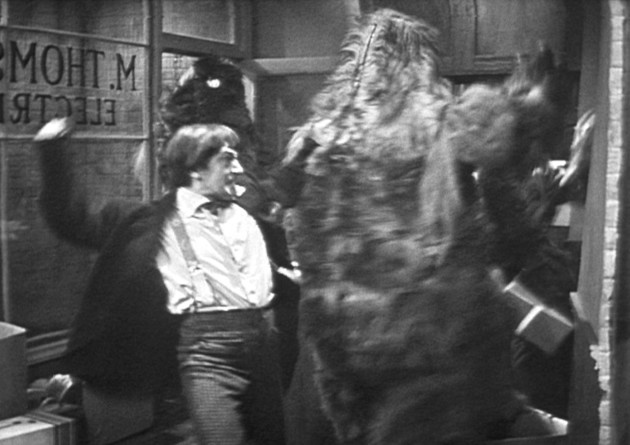
The Doctor and a Yeti in The Web of Fear
3. The Ice Warriors –The Ice Warriors and The Seeds of Death
The Ice Warriors are natives of the planet Mars. Large reptilian humanoids, the Ice Warriors can stand up to 7 feet in height. The Doctor and his companions first came upon the Ice Warriors at the Brittanicus Base where they had been frozen in ice for over 5,000 years. Defeated when their space craft exploded the Ice Warriors were next encountered on the Moon in The Seeds of Death. Their attempts at obtaining control of the Earth were foiled when the Doctor discovered that their seed pods were ruined by water. The Doctor then sent their space craft into an orbit around the sun.

The Doctor used his genius in an attempt to thwart death in The Seeds of Death
When the Ice Warriors were next met by the Doctor in 1972’s The Curse of Peladon they were members of the Galactic Foundation and had renounced violence. They became allies with the Doctor and remained so in a subsequent Third Doctor adventure, The Monster of Peladon (1974). In 2013’s Cold War the Ice Warriors’ pacifism was a long forgotten.

Pertwee era Ice Warriors
2. The Cybermen – The Tenth Planet, The Moonbase, The Tomb of the Cybermen, The Wheel in Space and The Invasion.
The Cybermen made their Doctor Who debut in William Hartnell’s last serial, The Tenth Planet. Very much humanoid in appearance, the Mark 1 Cybermen were possessed of a sing-song voice. Their faces were covered only with a stocking and they still retained their human hands. Unlike their successors, the first Cybermen initially did not seek to destroy the human race but rather hoped to convince them to join their “utopian” existence.

A Mark 1 Cyberman in The Tenth Planet
With the success of their first television appearance the Cybermen were quickly co-opted as rivals to the Dalek’s mantle of favourite Doctor Who monster. Each story in which they appeared saw their costumes modified, with the most substantial change occurring to the Mark 2 model. Gone were the stockinged faces and in their place were robotic heads. The five digits of their human hands were replaced by three fingered gloved hands.
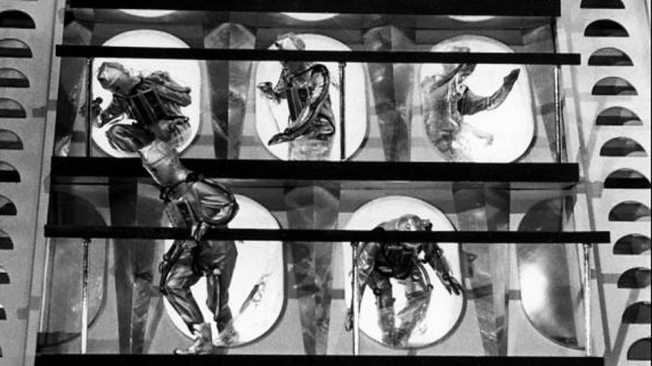
The Cybermen emerge from their icy tombs in this iconic image from The Tomb of the Cybermen
The Cybermen were the subject of two particularly iconic images of Sixties Who. Even the tackiness of breaking through new-fangled cling wrap was insufficient to dampen the effectiveness of the Cybermen’s emergence from their icy tombs in The Tomb of the Cybermen. Their appearance on, and march down, the steps of St Paul’s Cathedral in The Invasion was arguably the greatest cliff hanger of the era. Still images of the event have become part of popular culture.
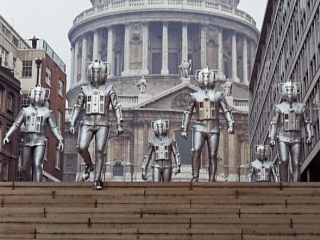
Perhaps the most iconic cliff hanger in classic series Doctor Who. The Cybermen on the steps of St Paul’s Cathedral in The Invasion
1. The Daleks – The Daleks, The Dalek Invasion of Earth, The Space Museum (cameo), The Chase, Mission to the Unknown, The Daleks’ Master Plan, The Power of the Daleks and The Evil of the Daleks
Only a brave person would nominate anything other than the Daleks as their favourite 1960s monsters. Appearing in just the second Doctor Who serial, it was arguably the Daleks that saved the show from a mere 13 week run. In a stroke of genius the Terry Nation created and Ray Cusick designed mutants immediately captured the imagination of the British public. Dalekmania was in full swing and within 18 months the Daleks would appear in the first of two colour, theatrically released movies.

Barbara is pinned against the wall in fear during the Daleks’ first appearance in Doctor Who on 21st December 1963
The Daleks featured in seven Sixties serials and appeared as a cameo in another. The 12 piece extravaganza The Daleks’ Master Plan is one of the most sought after missing serials. Only 3 episodes are held in the BBC Archives. Among other missing episodes is Mission to the Unknown, the only one part 1960s serial which also has the distinction of featuring none of the regular cast. Arguably the most missed of all Dalek serials is the Second Doctor’s first story, The Power of the Daleks. It, together with another missing story, The Evil of the Daleks, is highly revered in fandom. It can only be hoped that at least some of these missing episodes are some day recovered.

The 12 part The Dalek’s Master Plan is one of the most sought after missing Doctor Who serials
HONOURABLE MENTION
The Chumblies – Galaxy 4
Although the Chumblies were never reprised they were the most adorable Doctor Who monsters ever. Despite the Doctor, Steven and Vicki being initially frightened by them it soon became apparent that they were benign and worked for the good and just with the Rill. The Chumblies are top of my list of Sixties monsters that I’d most like to see revived.

A Chumbley with the Drahvins in Galaxy 4
Vivien Fleming
©Vivien Fleming, 2013.
